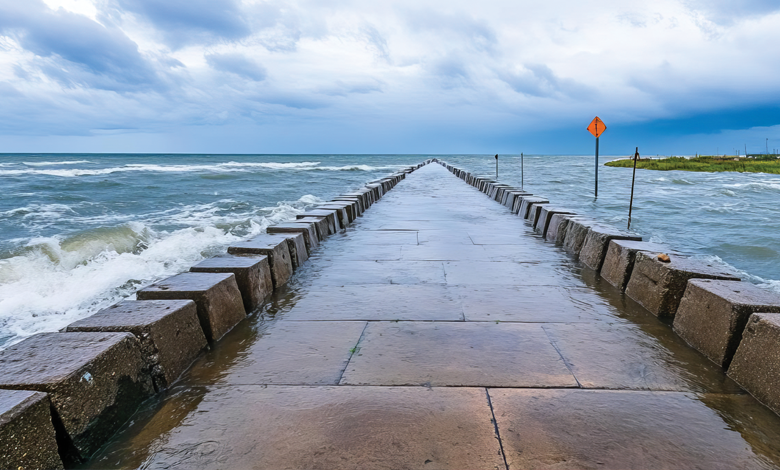
Dublin City Transport Plan: ‘Giving more space to public transport and active mobility’
13th September 2024
‘Nature needs politics’
7th November 2024A rise in sea level of 0.56 metres by 2050 could cost the State around €2 billion per year, with projected costs rising to €7 billion per year by 2100, research by the Economic and Social Research Institute (ESRI) has stated.
In a report, Climate change impacts and associated economic costs in Ireland, published in September 2024, the ESRI warns that, under a moderate warming scenario with a global sea level rise of 0.56 metres by 2050, the annual cost to the State is projected to be around €2 billion, escalating to €7 billion by 2100.
The study highlights that the damage costs are heavily influenced by population density and capital investments in coastal regions. The economic burden from storm surges and capital stock damage far exceeds that from land inundation and wetland loss.
Without additional adaptation measures, the severity of these impacts will increase. However, strategic adaptation measures, such as strengthening coastal defences, could significantly reduce these costs.
River flooding
River flooding is another crucial challenge, with the frequency and severity of floods expected to rise due to increased precipitation under climate change.
The Global Flood Risks with Image Scenarios (GLOFRIS) model, which assesses flood risk by integrating climate projections and socioeconomic factors, projects that under a no-adaptation scenario, the expected annual damage could reach €95 million by 2070.
However, with optimal adaptation strategies such as improved flood protection measures, the researchers state that these damages could be halved, underscoring the importance of proactively investing in flood defences, which can yield substantial economic benefits by reducing long-term flood risks.
Labour productivity
Rising temperatures and increased humidity are projected to have a direct impact on labour productivity, particularly in sectors that involve outdoor work, such as agriculture and construction. Even though Ireland’s temperatures remain below the global threshold for heat stress, the study notes a decline in productivity as temperatures increase.
This loss in productivity can result in a reduction in overall economic output. Given the importance of labour-intensive industries in Ireland, mitigating these productivity losses through adaptation strategies like adjusting working hours or improving workplace conditions is critical for maintaining economic stability.
Agriculture
While many impacts of climate change are negative, the researchers state their belief that the agricultural sector in Ireland may experience mixed effects. The paper reports that higher atmospheric CO2 concentrations and milder winters could improve the yield of certain crops such as barley and wheat, and boost grass production, which indirectly benefits livestock farming.
However, the analysis cautions that these positive effects could be offset by other challenges, including more frequent extreme weather events, pests, and diseases. The impact on agriculture underlines the complexity of climate change, where certain sectors might experience temporary benefits, but these could be undermined by broader, more disruptive effects.
Human health
Higher temperatures are also projected to have significant impacts on public health in Ireland. As temperatures rise, the frequency of heatwaves will increase, leading to more emergency hospital admissions.
The study shows that when maximum weekly temperatures reach 22°C to 25°C, emergency hospital admissions will rise by 4.7 cases per 100,000 people. This increase places additional pressure on the healthcare system and adds to the overall economic burden of climate change.
Recommendations
Underscoring the urgent need for Ireland to adopt a multi-faceted approach to adaptation, the ESRI calls for proactive investment in climate resilience, such as improved flood defences and coastal management, essential to mitigate the most severe impacts of climate change.
Additionally, while certain sectors like agriculture may experience short-term benefits, the broader economic risks posed by heat stress, flooding, and sea level rise, the ESRI asserts, require a cohesive, national response.
The publication of the ESRI report was swiftly followed by the Environmental Protection Agency’s (EPA) State of the Environment Report, which warns that measures taking place under the aegis of the Climate Action Plan are not sufficient to meet the State’s emissions reductions targets.
EPA Director General Laura Burke says: “We are taking positive actions across multiple fronts, but they are not keeping pace with the growing pressures, and our environment is being squeezed. We need to make a fundamental shift.”





 Ossian Smyth TD
Ossian Smyth TD Florika Fink-Hooijer
Florika Fink-Hooijer Antoine Oger
Antoine Oger Laura Curtis-Moss
Laura Curtis-Moss Anthony Costello
Anthony Costello Anja Murray
Anja Murray Niall Ó Donnchú
Niall Ó Donnchú Mike Savage
Mike Savage Brian Carroll
Brian Carroll Claire Downey
Claire Downey Oisín Coghlan
Oisín Coghlan Stephen Onakuse
Stephen Onakuse Kevin O’Sullivan
Kevin O’Sullivan Susan Hegarty
Susan Hegarty Hendrik W van der Kamp
Hendrik W van der Kamp Philip Nugent
Philip Nugent Adrian Smyth
Adrian Smyth  Ainhoa Gonzalez Del Campo
Ainhoa Gonzalez Del Campo  Geoff Dooley
Geoff Dooley  Clare Pillman
Clare Pillman  David Greenfield
David Greenfield Danielle Conaghan
Danielle Conaghan Peter McEvoy
Peter McEvoy Triona McGrath
Triona McGrath J Owen Lewis
J Owen Lewis Gavin Smith
Gavin Smith Imelda Hurley
Imelda Hurley Lucy Gaffney
Lucy Gaffney Dr Venkatesh Kannan
Dr Venkatesh Kannan Kevin Hegarty
Kevin Hegarty Eimear Cotter
Eimear Cotter Aditya Arora
Aditya Arora Patric Child
Patric Child Eleanor Roche
Eleanor Roche Andy Bleasdale
Andy Bleasdale Andrew Muir MLA
Andrew Muir MLA Chris Hewitt
Chris Hewitt Francesca Racioppi
Francesca Racioppi Christopher Hammond
Christopher Hammond Laura Díaz Anadón
Laura Díaz Anadón Lorna McAdoo
Lorna McAdoo Conor Murphy
Conor Murphy  Mark Horton
Mark Horton  Niall McLoughlin
Niall McLoughlin  Zoe Kavanagh
Zoe Kavanagh Niall Ó Donnchú
Niall Ó Donnchú Venkatesh Kannan
Venkatesh Kannan David McGee
David McGee Anna Rose
Anna Rose Paul Hogan
Paul Hogan








